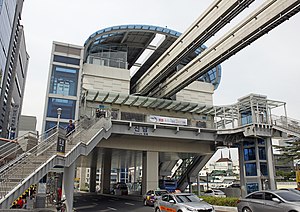
Daegu, formerly spelled Taegu and officially Daegu Metropolitan City, is a city in southeastern South Korea.

Gyeongju, historically known as Seorabeol, is a coastal city in the far southeastern corner of North Gyeongsang Province, South Korea. It is the second largest city by area in the province after Andong, covering 1,324 km2 (511 sq mi) with a population of 264,091 people as of December 2012. Gyeongju is 370 km (230 mi) southeast of Seoul, and 55 km (34 mi) east of Daegu. The city borders Cheongdo and Yeongcheon to the west, Ulsan to the south and Pohang to the north, while to the east lies the coast of the Sea of Japan. Numerous low mountains—outliers of the Taebaek range—are scattered around the city.
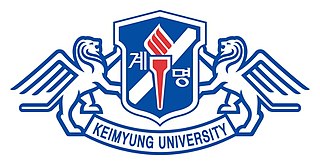
Keimyung University, abbreviated as KMU or Keimyung (啓明), is a private university located in Daegu, the fourth largest city in South Korea. The university takes roots from Jejungwon founded in 1899. The higher education started in 1954 with the support of the leaders of the Northern Presbyterian Church of the U.S. as a Christian university. KMU is composed of three campuses in the city of Daegu, South Korea. They are named for their locations within the city; Daemyeong, which is near the downtown area, Seongseo, which is in the western part of the city, and also Dongsan campus which includes Dongsan Medical Center. The university's Seongseo campus is known as one of the most beautiful campuses in South Korea.

Jung District is a gu, or district, covering the downtown area of Daegu, South Korea. It borders most of the other districts of Daegu, including Nam-gu to the south, Seo-gu to the west, Buk-gu to the north, and Dong-gu and Suseong-gu to the east. The northern border is formed by the Gyeongbu Line railroad, and the eastern border by the Sincheon stream.

The Gyeongbu high-speed railway, also known as Gyeongbu HSR, is South Korea's first high-speed rail line from Seoul to Busan. KTX high-speed trains operate three sections of the line: on 1 April 2004, the first between a junction near Geumcheon-gu Office station, Seoul and a junction at Daejeonjochajang station north of Daejeon, and a second between a junction at Okcheon station, southeast of Daejeon, and a junction near Jicheon station, north of Daegu entered service; then on 1 November 2010, the third section, between a junction west of Daegu and Busan became operational. The missing gaps across the urban areas of Daejeon and Daegu were in construction for an expected opening in 2014, separate tracks into Seoul Station were also planned. The temporary ends of the three sections were connected to the parallel conventional Gyeongbu Line by tracks that will serve as interconnector branches upon the completion of the entire line. On 1 August 2015, construction on urban areas of Daejeon and Daegu were completed; all the sections of HSR line were connected.

Daegu station is a station on the Gyeongbu Line and Daegu Metro Line 1 in Chilseong-dong, Buk District, Daegu, South Korea.

Jincheon Station is a station of the Daegu Subway Line 1 in Jincheon-dong, Dalseo District, Daegu, South Korea. Jincheon Station is in Jincheon crossroads between Wolbaero and Jincheonno. Jincheon Station was a train terminal from November 26, 1997, to May 10, 2002, when Daegok Station was opened. The station has nothing to do with Jincheon-gun Chungcheongbukdo; the place of the station is Jincheon-dong.

Yeungnam University Hospital Station is a station of Daegu Subway Line 1 in Daemyeong-dong, Nam District, Daegu, South Korea. It is located near the Yeungnam University Medical Center, Myeongdeok Market, Korea Buddhism University, Daeguaneumsa Temple and Nam-gu Office.

Myeongdeok Station is a station of Metro Line 1 and Metro Line 3 in Namsan-dong, Jung District, Daegu, South Korea. On March 13, 2009, an entrance elevator was installed. There is connection track to the No. 2 subway line between Banwoldang station and Myeongdeok station.
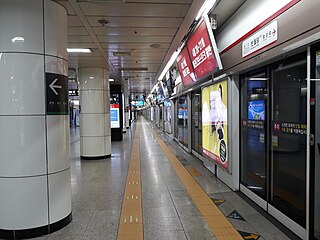
Banwoldang Station is a station of the Daegu Metro Line 1 and Line 2 in Deoksan-dong, Jung District, Daegu, South Korea. Banwoldang Station is the only transfer station of Daegu Metro. Banwoldang underground shopping was created with the second line opening.

Dongchon Station is a station of the Daegu Subway Line 1 in Geomsa-dong, Dong District, Daegu, South Korea. It is located at Dongchon old course (동촌구길). As it is connected with Ayanggyo station by underwater tunnel, it is deeper than any other station of Daegu Subway Line 1.
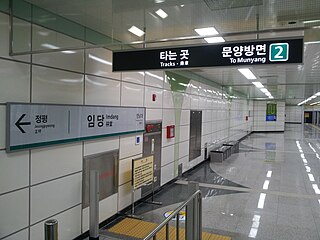
Imdang Station is a station of Daegu Metro Line 2 in Imdang-dong and Jungbang-dong, Gyeongsan, North Gyeongsang Province, South Korea.

Gosan Station is a station of the Daegu Metro Line 2 in Siji-dong, Suseong District, Daegu, South Korea. While Siji-dong is a single legal dong, Gosan-dong is the administrative dong.
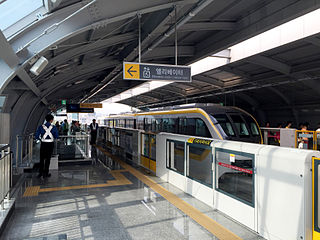
Seomun Market Station is a station of Daegu Subway Line 3 in Daesin-dong, and Sijangbungno, Jung District, Daegu, South Korea. It is named after Seomun Market, and is also called Dongsan Medical Center Station.
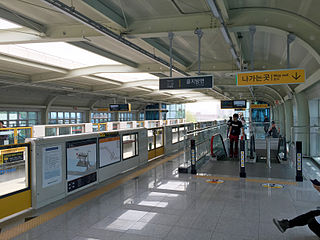
Maecheon Market Station is a station of Daegu Metro Line 3 in Maecheon-dong, Buk District, Daegu, South Korea.
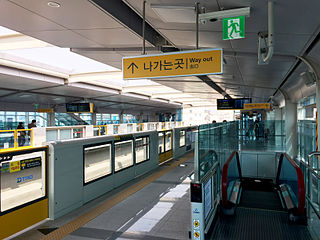
Paldal Market Station is a station of the Daegu Metro Line 3 in Nowon-dong, Buk District, Daegu, South Korea.
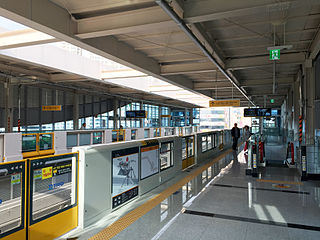
Suseong Market Station is a station of the Daegu Metro Line 3 in Suseong-dong, Suseong District, Daegu, South Korea.
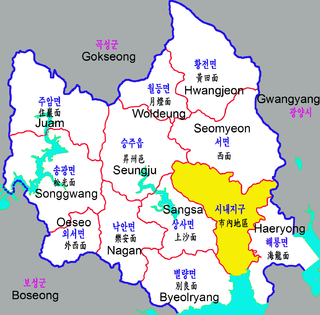
Seo-myeon, also called Seo Township, is a myeon (township) in Suncheon, a city in the South Jeolla Province, South Korea. Name of the township means West Township, but it is located in the eastern part, not western part, of the city with a total area of 103.54 square kilometres (39.98 sq mi). The population was recorded to be 12346 people, 6141 males and 6205 females, and the number of houses totaled 4979. The township office is located in 94, Imchondong-gil in Dongsan-ri. There are Bonggang-myeon, Gwangyang in the east of the township, Seungju-eup in the west; Samsan-dong and Wangjo-dong in the south; Woldeung-myeon in the north-west; and Hwangjeon-myeon in the north.
Retailing in South Korea consists of hypermarkets, department stores, flea markets, traditional markets, and underground shopping malls. Hypermarkets sell dry goods and groceries, similar to Western supercentres. Traditional markets are also popular throughout South Korea.
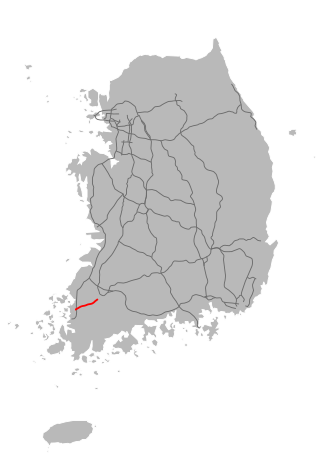
Muan–Gwangju Expressway also known as 12th Expressway is an expressway in South Korea connecting Muan County to Gwangju.
